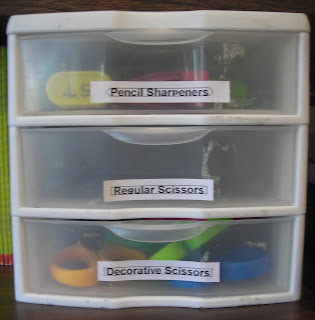"I can't find a book!"
Every teacher dreads hearing this from a student. I have found a way to bring order to the chaos of my hundreds of books. The best part is, I no longer hear that dreaded phrase.
My secret weapons? Plastic bins from the dollar store, recycled cardboard boxes, a lot of dedication,
The Classroom Booksource website, and lots of time to put it all together.
This portion of the library hosts genre bins for genres like comics, realistic fiction, mystery, science fiction, historical fiction, and fantasy. I actually have 3 whole bins for fantasy - obviously it's our favorite genre.
This side of my library consists mainly of reading series like Percy Jackson, Inkheart, Septimus Heap, Flat Stanley, and Narnia. There are also bins for well-known authors like Gary Paulsen, Patricia MacLachlan, Judy Blume, and Beverly Cleary. There are leveled book bins on this side as well. These books are labeled using guided reading level letters. Once students find books at their comfort level, they can utilize these bins for similarly matched books.
Newbery winners and honor books are kept in these large plastic bins with room for yearly additions. I recommend that my students try reading at least some of these classics.
No space in my library is left unused. I have used various shallow plastic bins (all from the dollar store) for groups of books and magazines stored beneath the large book shelf.
This is my new favorite bin! I began with a cardboard box that housed paper coffee cups and covered it with construction paper. I got the circular sign free with a
Scholastic book order and I taped it to the top of the cardboard box. Once I added a label, it was done!
My library is my baby (can you tell?) and I'm so proud to share it. It's been a few years of working out the kinks, but I'm in a place where I'm so happy with how things are organized. I can honestly say that every container was either free (recycled cardboard boxes) or just $1 (yes, every plastic bin is from the dollar store - some even came in groups of 3 for a dollar). What could be better? That means I can spend my money buying books instead of containers.
The Classroom Booksource website was my newest addition to my library protocol. This summer, I spent hours cataloging every book in my library onto this FREE website. This website also allowed me to document which bin each book belongs in. The O.C.D. side of me
fell in love with this website at first sight! Even though many of my coworkers think I'm crazy for spending so much time with this process, I know that it was the right choice for me. It will help me (and my students) keep track of my books - which total over 650 as of right now! A place for every book, and every book in its place . . .
Now that you know how everything is organized, it's time to talk about what this means for my students. First of all, my students find the book bins to be important tools to choosing well-fitting books. Students know that if they love a genre, they can find books in it. If they love a series, they know where to look. If they want a particular level, there's a bin for it. Once they find the perfect book, checking out books is a two step process:
- Students find their name on The Classroom Booksource website. They search for the book they are checking out, and mark that they have it. (They also return books on the websie
- Students use their numbered clothespins to clip to the bin where they took a book from. Three clothespins = three books can be out at a time.
This side wall of the library is where students use personalized clothespins to check out books.
The clothespins (in addition to being budget-friendly) serve a dual purpose. They help me visually see how many books each student is reading (a missing pin means a book is checked out). The pins also help my students remember where to book their books back. They clip the pin on the bin where they got the book. When it's time to return a book, they find the pin with their number to return a book to it's home.
Another benefit of the clothespins? I can see what genres or series my students are reading. This helps me order more books that correlate to what the kids truly enjoy.
Students who forget where to return their books or have ripped books, place their books in this "medical box." The classroom librarians determine if the books should simply be returned to their rightful place or if they should give them to me for repairs.
Is this already too crazy for you to wrap your mind around? Well, I take it even further . . . hello, OCD teacher here! Inside each book cover is helpful information for both me and my students. Book information listed includes the book's genres (a star indicates the book bin), guided reading level (letter), and lexile level (number). These labels help everyone find appropriate books - be it by level or genre. How empowering for students to pick up a book, flip to the back cover, and be able to decide if it may be a worthwhile choice for themselves!
Whew! So that's my classroom library. I'm sweating just thinking about everything it took to get it to this point. I also am looking back over this post realizing that I'm like that proud parent talking about every little cute detail. What can I say? This project really is my baby :)



















































